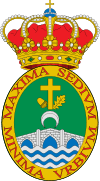Cangas de Onís
| Cangas de Onís Cangues d'Onís | |||
|---|---|---|---|
| Municipality | |||
|
The hump-backed "Roman Bridge" on the Sella River | |||
| |||
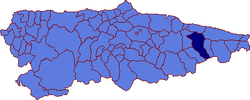 | |||
 Cangas de Onís Location in Spain | |||
| Coordinates: 43°21′N 5°8′W / 43.350°N 5.133°W | |||
| Country |
| ||
| Autonomous community |
| ||
| Province | Asturias | ||
| Comarca | Oriente | ||
| Judicial district | Cangas de Onís | ||
| Capital | Cangas de Onís | ||
| Government | |||
| • Alcalde | Jose Manuel González Castro (PP) | ||
| Area | |||
| • Total | 212.75 km2 (82.14 sq mi) | ||
| Highest elevation | 2,478 m (8,130 ft) | ||
| Population | |||
| • Total | 6,731 | ||
| • Density | 32/km2 (82/sq mi) | ||
| Demonym(s) | cangués | ||
| Time zone | CET (UTC+1) | ||
| • Summer (DST) | CEST (UTC+2) | ||
| Postal code | 33547 to 33559 | ||
| Website | Official website | ||
Cangas de Onís (Asturian: Cangues d'Onís) is a municipality in the eastern part of the province and autonomous community of Asturias in the northwest of Spain. The capital of the municipality is also Cangas de Onís.
More than seventy square kilometres of the concejo form part of the Parque nacional de los Picos de Europa. Within the park is the village of Covadonga, where the battle of Covadonga (about 722), the first major victory by a Christian military force in Iberia after the Islamic conquest, marks the starting-point of the Reconquista.
Until 774, Cangas de Onís was the capital of the Kingdom of Asturias. It was the site of the first church constructed in post-conquest Iberia, Santa Cruz de Cangas de Onís (737), built on an ancient dolmen.
Vegetation
Given its varied height it has many types of plants, including many mountain shrubs, heather; oak, have and ash trees, rounded by grassland and copes.
Economy
The main economic activities of this region are agriculture and cattle rearing along with rural tourism. The nearby Covadonga Sanctuary and its surrounding lakes are one of the main tourist destinations in Asturias.
Parishes
Cangas de Onís is divided in eleven parishes:
The capital of the municipality is the parish of Cangas de Onís. It is 27.22 km2 (10.51 sq mi) in size with a population of 4,326 (INE 2005). The postal code is 33550 and is divided in several villages:
- Cañu
- Cabielles
- Cangues
- Cardes
- Celangu
- Ḥelgueres
- Llueves
- Ñarciandi
- Ñeda
- Onao
- Següencu
- Torió
- Tornín
Gallery
-

13th century bridge over Rio Sella
-

Town Hall in Cangas de Onís
-
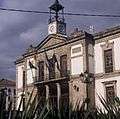
Town Hall
-

Statue of the King Pelayo
-
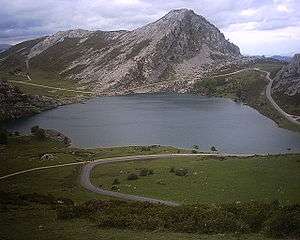
Enol Lake at Covadonga
-

Holy Cave of Covadonga
-
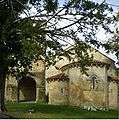
Monastery of San Pedro de Villanueva (12th century) - Church
-

Church of Santa Cruz - Lateral side
-
_-_04.jpg)
Chapel of Santo Medero
-

Pintu Palace
External links
| Wikisource has the text of the 1911 Encyclopædia Britannica article Cangas de Onís. |
- Guía turística (Spanish)
- www.cangasdeonis.com (Spanish)
- Cangas de Onís (Spanish)
- Casa Rural (Spanish)
- Cangas de Onís
Coordinates: 43°21′00″N 5°07′00″W / 43.35°N 5.116667°W


